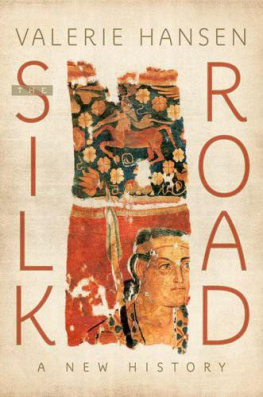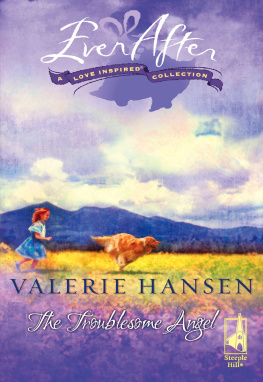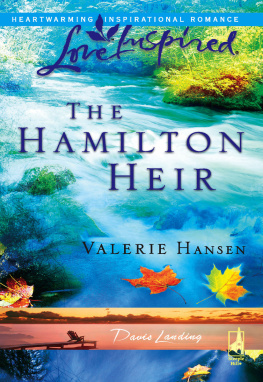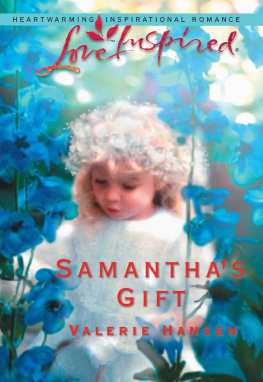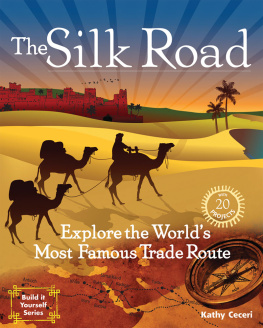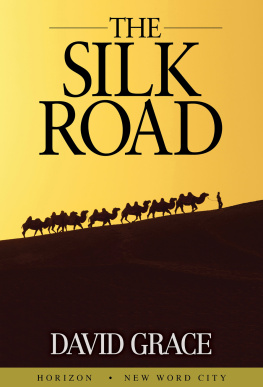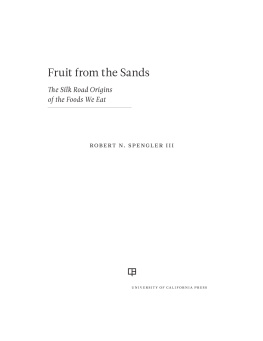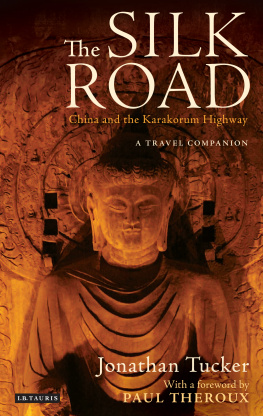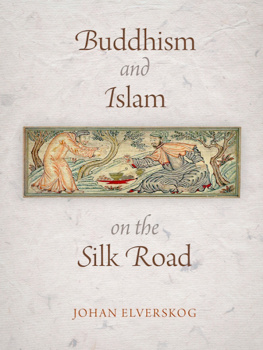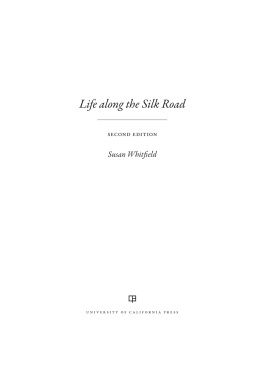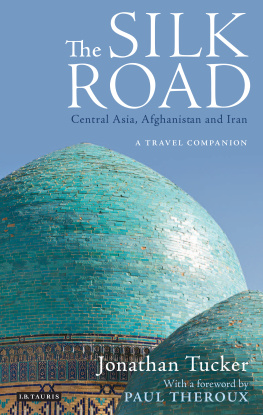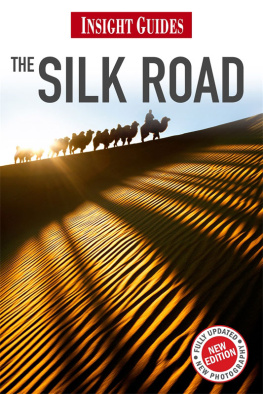The Silk Road
The SILK ROAD
A NEW HISTORY
Valerie Hansen


Oxford University Press is a department of the University of Oxford.
It furthers the Universitys objective of excellence in research,
scholarship, and education by publishing worldwide.
Oxford New York
Auckland Cape Town Dar es Salaam Hong Kong Karachi
Kuala Lumpur Madrid Melbourne Mexico City Nairobi
New Delhi Shanghai Taipei Toronto
With offices in
Argentina Austria Brazil Chile Czech Republic France Greece
Guatemala Hungary Italy Japan Poland Portugal Singapore
South Korea Switzerland Thailand Turkey Ukraine Vietnam
Oxford is a registered trademark of Oxford University Press in the UK and certain other countries.
Published in the United States of America by
Oxford University Press
198 Madison Avenue, New York, NY 10016
Valerie Hansen 2012
All rights reserved. No part of this publication may be reproduced, stored in a retrieval system, or transmitted, in any form or by any means, without the prior permission in writing of Oxford University Press, or as expressly permitted by law, by license, or under terms agreed with the appropriate reproduction rights organization. Inquiries concerning reproduction outside the scope of the above should be sent to the Rights Department, Oxford University Press, at the address above.
You must not circulate this work in any other form and
you must impose this same condition on any acquirer.
Library of Congress Cataloging-in-Publication Data
Hansen, Valerie, 1958
The Silk Road : a new history / Valerie Hansen.
p. cm.
Includes bibliographical references and index.
ISBN 978-0-19-515931-8 (hardcover : acid-free paper)
1. Silk RoadHistory. 2. Silk RoadHistorySources.
3. Silk RoadDescription and travel. 4. Silk RoadHistory, Local.
5. Historic sitesSilk Road. 6. Trade routesAsiaHistory. I. Title.
DS33.1.H36 2012
950.1dc23 2011041804
1 3 5 7 9 8 6 4 2
Printed in the United States of America
on acid-free paper
For Jim
who else?
Contents
Color plates follow
Acknowledgments
T his project has been a long time in the making, and many people have provided materials, answered questions, and helped in different ways. Since the first endnote to each chapter gives a detailed account of the assistance I have received, here I would like to single out those individuals whose help far surpassed the usual expectations of scholarly collegiality:
Phyllis Granoff and Koichi Shinohara, Yale University, for wise counsel about diverse Asian religious traditions usually dispensed over delicious family meals at their house;
Frantz Grenet, Centre Nationale de la Recherche Scientifique, for imparting his knowledge of Central Asian Art and his personal collection of images, some made by the talented Franois Ory;
Stanley Insler, Yale University, who first encouraged me to enter this field by agreeing to teach a joint class on the Silk Road and who was always willing to answer more questions over yet another lunch at Gourmet Heaven;
Li Jian, Virginia Museum of Fine Arts, who recruited me to work on a Silk Road exhibit at the Dayton Museum and introduced me to the Hejiacun finds;
Victor Mair, University of Pennsylvania, for unceasing help since he first taught me in a graduate seminar on the Dunhuang documents thirty years ago;
Boris Marshak, Hermitage Museum, who generously gave of his knowledge in conversations about and lectures on the Sogdians before his death in 2006;
Mou Fasong, East China Normal University, who hosted my family during the academic year 20056 and showed by example how his advisor Tang Zhangru approached his studies;
Georges-Jean Pinault, cole Pratique des Hautes tudes, for his guidance on IndoEuropean languages, particularly Tocharian;
Rong Xinjiang, Peking University, for his unrivaled knowledge of the region and willingness to lend his personal library of books and articles;
Angela Sheng, McMaster University, for her expertise on textiles and her loyal friendship;
Nicholas Sims-Williams, School of Oriental and African Studies, University of London, and Ursula Sims-Williams, British Library, London, who both patiently corrected multiple errors in an article I submitted to the Bulletin of the Asia Institute and for guidance on Central Asian languages, particularly Khotanese;
Prods Oktor Skjrv, Harvard University, who has over the years answered frequent queries, traveled to Yale to give multiple presentations, and provided copies of his own unpublished translations;
tienne de la Vaissire, cole Pratique des Hautes tudes, for his unfailing generosity in answering queries about all things Sogdian and many things Central Asian, often within an hour and always within a day (even in my last weeks of revising);
Wang Binghua, Renmin University, for sharing his deep knowledge of Xinjiang archeology, particularly about the sites of Niya and Loulan;
Helen Wang, British Museum, for her command of numismatics and for close readings of multiple chapters; and
Yoshida Yutaka, Faculty of Letters, Kyoto University, for his advice on Sogdian and Khotanese language and history.
Susan Ferber, my editor at Oxford University Press, has been consistently supportive since signing this book more than a decade ago, and her careful edits improved each chapter. She answered all queries with unusual alacrity, possibly because she works harder than anyone I have ever met. Joellyn Ausanka, senior production editor, oversaw the preparation of the book with extraordinary efficiency, while Ben Sadock copyedited with a gentle touch and great acuity.
The National Endowment for the Humanities provided a year of support that allowed me to study Russian and, with the help of Asel Umurzakova, immerse myself in the Mount Mugh materials. The Fulbright Scholar Program for Faculty financed my stay at East China Normal University in Shanghai, 20056. The Chiang Ching-Kuo Foundation for International Scholarly Exchange (USA) provided a generous subsidy for maps and illustrations.
All the Yale undergraduate and graduate students who have taken classes on the Silk Road over the years have pushed me to clarify my arguments. Elizabeth Duggan provided an insightful reading of an early draft of the introduction. The students in my Silk Road seminar in the spring of 2010, Mary Augusta Brazelton, Wonhee Cho, Denise Foerster, Ying Jia Tan, and Christine Wight, and, in the spring of 2011, Arnaud Bertrand, read through an almost-final draft and made many valuable suggestions for revision, including starting each chapter with a document. Mathew Andrews, my research assistant, performed multiple tasks, especially the tedious preparation of images, with speed and good cheer, even as a first-year student at Yale Law School. Joseph Szaszfai and the staff of Yales Photo + Design unit transformed many problematic images into digital files ready for publication.
Brian Vivier, now Chinese Studies librarian at the University of Pennsylvania, carefully edited all the endnotes. Jinping Wang helped to resolve multiple last-minute queries with her characteristic erudition. Alice Thiede of Carto-Graphics drew the beautiful maps, which were particularly challenging because of all the unfamiliar place-names. Pamela Schirmeister, associate dean of the Yale Graduate School, offered an incisive critique of the introduction just days before submission.
My husband, Jim Stepanek, and our children, Bret, Claire, and Lydia, have always supported my writing and teaching with good humor. No question that the best trips have been when they, either individually or collectively, were along. The final month in China before submission was an all-out family effort to proofread, prepare charts, and polish the manuscript. What will we ever talk about now that Bret, born just before I began this project, can no longer tease me about the average number of words I wrote each day?
Next page
